Located in far-western Nepal, these regions encompass peaks ranging from 5,970 meters (19,590 feet) to 7,132 meters high, but historically attract few climbers due to challenging access. Himal Gautam, the director of Nepal’s Tourism Department, emphasized that the initiative could stimulate local economies by creating jobs and boosting income through tourism.
The recent decision comes against the backdrop of growing concerns regarding the environmental impacts and overcrowding on Everest, where 421 climbing permits were issued in 2024 alone. This has led Nepal's Supreme Court to advocate for limitations on the number of permits issued, stressing that the mountains’ carrying capacity must be adhered to.
While the local government hopes that removing fees for the remote peaks will entice climbers, questions remain on whether infrastructure improvements will accompany this initiative to handle a potential influx of visitors. Only 68 climbers attempted these peaks in the past two years, highlighting the challenge the government faces in making these offerings appealing.
Additionally, authorities are considering a new regulation requiring climbers to first summit a mountain over 7,000 meters in Nepal before attempting Everest, making the newly free peaks potentially valuable training grounds. These developments underscore Nepal's commitment to promoting sustainable tourism while grappling with the rapid growth of climbers drawn to its most famous peak.
The recent decision comes against the backdrop of growing concerns regarding the environmental impacts and overcrowding on Everest, where 421 climbing permits were issued in 2024 alone. This has led Nepal's Supreme Court to advocate for limitations on the number of permits issued, stressing that the mountains’ carrying capacity must be adhered to.
While the local government hopes that removing fees for the remote peaks will entice climbers, questions remain on whether infrastructure improvements will accompany this initiative to handle a potential influx of visitors. Only 68 climbers attempted these peaks in the past two years, highlighting the challenge the government faces in making these offerings appealing.
Additionally, authorities are considering a new regulation requiring climbers to first summit a mountain over 7,000 meters in Nepal before attempting Everest, making the newly free peaks potentially valuable training grounds. These developments underscore Nepal's commitment to promoting sustainable tourism while grappling with the rapid growth of climbers drawn to its most famous peak.





















